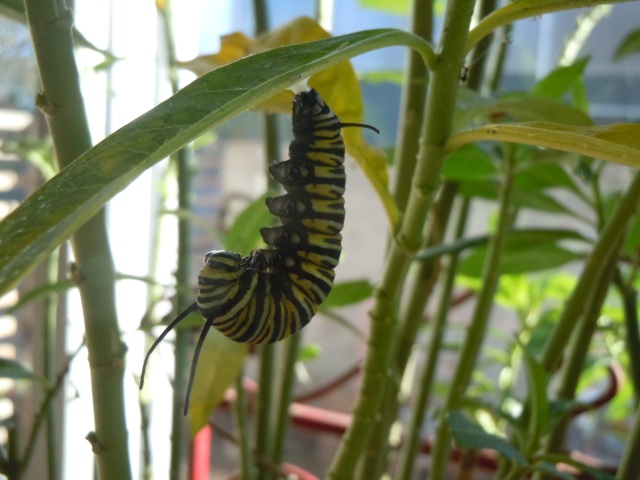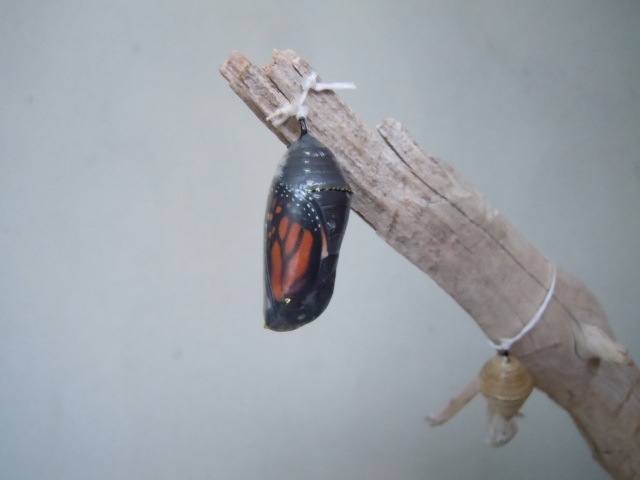Several emails like the one below landed in my mailbox this week seeking counsel on what to do about late season Monarchs.
Hi Monika,
My friends found seven Monarch caterpillars on a well- protected piece of milkweed. Six are gone, but one spun a chrysalis that they are protecting. Do you have any advice? We are wondering how long it will be in the chrysalis state in the winter. Thanks for any advice you can give.
Dale
I would bring it inside, Dale–but that’s just me.
Usually it takes 10 – 14 days to eclose, or become a butterfly, but cooler temps can extend the process. Caterpillars I

Monarch caterpillar makes its "J" shape and readies to form its chrysalis, 12/21/2011 in my kitchen.
found on potted milkweed in mid December and brought inside hatched just last week and flew off on a warm 70-degree afternoon. But it could easily have gone the other way, with an ice storm hitting just as my butterflies hatched. Then what?
Deciding whether or not to adopt in-process butterflies during the off-season always presents a quandary. Questions to ask:
- Do you have nectar available? Newborn butterflies generally don’t need to eat for the first 24 hours, but then they’ll need sustenance.
- What about host plants? A butterfly’s first priority is to mate (for males) and lay eggs (for females) on their specific host plant.
- Will the weather cooperate? Butterflies don’t fly when it’s less than 65 degrees. Most will die with a freeze.
With our crazy Texas weather, Monarchs and other butterflies can hatch throughout the year depending on temperatures and host plant availability. As noted last week, Monarchs are reproducing regularly on the San Antonio River — even into January. Whether or not the eggs of those late season couplings make it to the butterfly stage is a crap shoot dictated by Mother Nature.

Monarch butterfly about to hatch in my kitchen
Generally, if I have host plants, I take found caterpillars into my kitchen to increase their chances of becoming a butterfly. Studies suggest that caterpillars and eggs left entirely to nature have a 10% chance of becoming a butterfly. When we lend a hand the odds are flipped–with a 90% chance.
What’s sad is when butterflies hatch and enter a world with no potential mates, no nectar and no host plants. I once bought several chrysalises at Butterfly World, the Disneyland”

Tropical milkweed on the San Antonio River Walk 1/04/2012
of butterflies and a worthy destination for butterfly fans in Coconut Grove, Florida. I returned to Texas in mid December with Luna and Polyphemus Moth cocoons, and a Giant Swallowtail chrysalis.
I pinned each to the curtain of my kitchen window as directed, providing the bright light that can speed up development.
The Luna Moth hatched beautifully and was released on a relatively warm January evening. The Polyphemus Moth never hatched. When the Giant Swallowtail eventually eclosed–about six weeks after purchase–an ice storm raged outside. A week of cold and freeze followed. The poor creature flailed around on my kitchen floor, refusing the cut flowers and diluted Gatorade I offered via Q-Tip. After three sad days, the Swallowtail perished.
For Monarchs, this may not be a problem if you have milkweed growing year round. The non-native but easily adapted Asclepias curassavica, sold in many nurseries as Tropical milkweed, provides nectar and host plant material and grows gregariously in pots that can be moved in and outside.
That said, some Monarch scientists, including our friend Dr. Lincoln Brower, worry that cultivating Monarch butterflies on Tropical milkweed year round can result in undesirable colonies of Ophryocystis elektroscirrha, or OE, a protozoan disease that infects Monarchs and other milkweed feeders. OE is present in the landscape but seems to especially flourish on Tropical milkweed in southern climates late in the year. In colder climates and the wild, milkweeds die off in the winter, apparently purging OE to a large degree.
Scientists speculate that local OE-infested Monarchs will breed with migrating populations, possibly jeopardizing the migration. Butterfly breeders and enthusiasts argue that OE is like staphylococcus–present in our populations and getting out of hand only under stressed circumstances. Some believe that OE is simply a part of the evolutionary cycle, killing those butterflies less fit than others.
The answer, Dale, is that it’s a cold, cruel world for butterflies caught in flighty Texas winters–and an uneasy call for butterfly fans seeking to lend them a hand.
Like what you’re reading? Don’t miss a single post from the Texas Butterfly Ranch. Sign up for email delivery in the right navigation bar on this page, like us on Facebook, or follow us on Twitter, @butterflybeat.
Hi Monika
In Michigan our season is long over so it is nice to hear about the babies in Texas. I did here though that their is a study that maybe the tropical milkweed is like a medicine for the egg/lavae stage. Monarch Health I think it was. What have you heard? I’d like to experiment raising some of my monarchs on tropical and some on common and then have them test for OE. I would start out with clean plants but the egg/larvae would be wild collected. What do you think?
Sue
HI Sue,
It’s my understanding from talking to butterfly breeders that the protozoa of OE is carried on the butterfly scales. That means that an infected wild Monarch could lay an egg and the egg could pick up the OE from being laid. Breeders typically isolate bred Monarchs from wild because of this reason–to keep the wild ones from infecting their breeding stock. To take extra precautions, breeders often even disinfect Monarch eggs with a diluted bleach solution before they hatch.
So…I think your experiment would require that the Monarchs laying the eggs are OE free. The only way to do that is inspect them with a microscope. Breeders do this by using a piece of tape to gather cells from the Monarchs abdomen, then looking at the tape under a microscope.
Yeah, I know. Big chore. Yet if you don’t do that, your experiment will yield faulty results. Good luck!
Monika
Hi Monika,
Can you please provide a list of suitable butterfly-attracting plants? I have the milkweed going (in pots), and the garden is ready to receive it and any other food sources you deem appropriate. But is it too early to put stuff in the ground in Austin? We had a hard freeze last night and will continue to live in uncertainty for at least another month.
t.
Teresa, did you want nectaring plants to attract adult butterflies of any species? or, larval host plants to attract just certain species which will lay eggs on them and hatching caterpillars will eat until they pupate?
HI Teresa,
There’s some things you can put in the ground right now–certain lantanas (great nectar plant), fennel, parsley and dill (frost tolerant Swallowtail host plants) and even some milkweed, if it’s well rooted. It might freeze, but it will come back. You can also plant wildflowers like Cowpen Daisy, Jimsonweed, etc., or you can just wait until the nurseries bring out the spring seedlings for transplants. In Austin, the last freeze date is around March 15, so you only have two months to go. Another option is to start things inside (like sunflowers) and then pop them in the ground in late March. There’s so many ways to go, and much depends on how much work you want to do or not–ie do you want to have to cover your plants in the event of a hard freeze. Your call.
Thanks for stopping by!
Monika
Sonia Altizer own research shows OE. infection rates are actually low in some non-migratory monarch populations where the butterflies breed year round on evergreen tropical milkweed.


In her 2000 paper: http://tinyurl.com/6z7zjse Sonia reported low OE infection rates in several tropical latitude locations that she sampled:
Specifically, she found low OE infection rates in:
45 monarchs from Mt. Crosby, Queensland, Australia
24 monarchs from Rockhampton, Queensland, Australia
6 monarch from Venezuela
27 monarchs from Columbia
11 monarchs from Trinidad (none of them had O.e. Spores)
So the notion that “OE seems to especially flourish on Tropical milkweed in southern climates late in the year” is somewhat speculative. And the notion that “local OE-infested Monarchs will breed with migrating populations, possibly jeopardizing the migration” has problems too because in the temperate zone latitudes of Australia and New Zealand, the monarch migrations there are 100% dependent on tropical evergreen milkweed because that’s the only kind of milkweed that grows. So far from threatening their migrations, tropical milkweed sustains them. Here are photos of the overwintering clusters in New Zealand: http://www.monarch.org.nz/monarch/2011/05/20/monarchs-clustering-in-washbourn-gardens-richmond-nelson/
Hi, Monika! I’m facing the same quandary. I’m in S.A., and Wednesday I noticed a couple of cats on a potted milkweed in the front yard– one’s a Queen cat, and the other’s a Monarch. The leaves are all splotchy— green and a reddish-brown– and of course the whole plant is covered in yellow aphids. I brought it inside, aphids and all, because it was supposed to freeze that night and the next. (And we might’ve had a freeze last night too— don’t know yet.) I have two questions for you. 1) Can the cats do alright on such ugly leaves? 2) I ALSO have a couple of tall Milkweed plants inside, grown from seed, that are mostly green, but are covered with—NOT yellow aphids, but teeny-tiny white flies. Can the cats that I brought in from outside survive better on the leaves of the plant that is all green and brown splotchy, or on the one that was grown inside that has white flies?
Thank you!